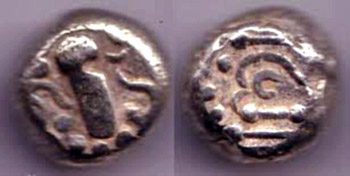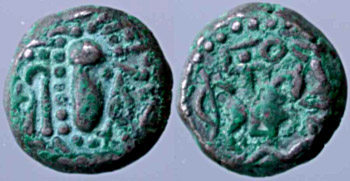 Coins of Malwa Plateau were not indigenous. While there is little evidence for indigenous coinage in Malwa before the 13th century, it is hard to believe that the economy of a Rajput state could function without money of any kind. Most of its residents were engaged in agriculture, but there were after all major cities with urban populations which required an exchange medium in ordering their material affairs. Further, there are literary and epigraphic records attesting to the collection of various forms of taxes, cesses and duties in the Paramara state during this period. The amount of some of these levies has been given in actual coin denominations: vimsopaka (a copper coin), rupaka (a silver coin), dramma and parutha dramma (gadhaiya paisa coins). Since the major market for Malwa products was in Broach and other foreign port cities, there is certain logic to this. If the determinant of prices for many manufactured and surplas agricultural goods of Malwa were the market in Gujarat, there was a certain convenience in using the money of that country in Malwa itself.
Coins of Malwa Plateau were not indigenous. While there is little evidence for indigenous coinage in Malwa before the 13th century, it is hard to believe that the economy of a Rajput state could function without money of any kind. Most of its residents were engaged in agriculture, but there were after all major cities with urban populations which required an exchange medium in ordering their material affairs. Further, there are literary and epigraphic records attesting to the collection of various forms of taxes, cesses and duties in the Paramara state during this period. The amount of some of these levies has been given in actual coin denominations: vimsopaka (a copper coin), rupaka (a silver coin), dramma and parutha dramma (gadhaiya paisa coins). Since the major market for Malwa products was in Broach and other foreign port cities, there is certain logic to this. If the determinant of prices for many manufactured and surplas agricultural goods of Malwa were the market in Gujarat, there was a certain convenience in using the money of that country in Malwa itself.
Scholars also suggest that shortly before AD 1218, an indigenous coinage was started in Malwa. This continued in a long series, with possible termination dates in the successive conquests of the Paramara kingdom by the Khalji Sultans of Delhi in AD 1291 and 1302. The very earliest of the Malwa coins have obverse stylised head designs very similar to the range of Somala Devi coins. The obverse of the earliest coin of Malwa Plateau retained the ear ornament of the Chaulukyan gadhaiya prototypes. The Malwa issue was further characterised by a `fish-hook` to the right-of the face, which the Gujarat coins lacked. This became the main distinguishing feature of the entire Malwa billon coin series. The weight standard was increased by 10 per cent, and the fire altar reverse replaced by a battle scene, in which a horseman waving a sword tramples an unresisting figure below and attacks a standing figure to the right.
 Gadhaiya coins show their presence in western, southern, eastern and northern Malwa, but not in the interior. The treasure trove records of the erstwhile Central Provinces and present Madhya Pradesh do not differentiate between gadhaiya paisa and `Indo-Sassanian` coins, as was done in Gujarat, Rajasthan and Uttar Pradesh. The Malwa plateau is the inclined tableland north of the natural east-west boundary provided by the Vindhya Range and Narmada River. In the eleventh through thirteenth centuries it was governed by kings of the Paramara Rajput clan. Their scat of government was at Dhara. Politically its position was unfortunate, since it lacked natural barriers except on the south, and was generally open to attack from all quarters. The integrity of the Paramara kingdom was consequently dependent on the diplomatic and military skills of the court. The surplus agricultural production of the region was the basis of the royal revenues; Malwa had neither sea coast nor major navigable river, and was thus dependent on other kingdoms, especially Gujarat, for access to markets. Thus, both politically and economically, the independence of the Paramara kingdom was tenuous. Given these conditions it is not surprising that the economy of Malwa was dependent on the currency of neighbouring Gujarat.
Gadhaiya coins show their presence in western, southern, eastern and northern Malwa, but not in the interior. The treasure trove records of the erstwhile Central Provinces and present Madhya Pradesh do not differentiate between gadhaiya paisa and `Indo-Sassanian` coins, as was done in Gujarat, Rajasthan and Uttar Pradesh. The Malwa plateau is the inclined tableland north of the natural east-west boundary provided by the Vindhya Range and Narmada River. In the eleventh through thirteenth centuries it was governed by kings of the Paramara Rajput clan. Their scat of government was at Dhara. Politically its position was unfortunate, since it lacked natural barriers except on the south, and was generally open to attack from all quarters. The integrity of the Paramara kingdom was consequently dependent on the diplomatic and military skills of the court. The surplus agricultural production of the region was the basis of the royal revenues; Malwa had neither sea coast nor major navigable river, and was thus dependent on other kingdoms, especially Gujarat, for access to markets. Thus, both politically and economically, the independence of the Paramara kingdom was tenuous. Given these conditions it is not surprising that the economy of Malwa was dependent on the currency of neighbouring Gujarat.
The only coins attributable to the Malwa Plateau are very rare. Lakshmi base gold coins, and derivative smaller Lakshmi-type silver coins, equally rare. A standard format Lakshmi gold coin, normally 4.05 g weight, was struck in the name of Udaya Deva, who is equated with the Paramara Udayaditya, around AD 1070-86. Another particular heavy Lakshmi gold coin of nearly 5.6 g and its half unit of 3.0 g were struck in the name of Nara Varman, son of Udayaditya. A particular hybrid small silver coin of Malwa Plateau with a simplified standard Lakshmi format, weight 2.45 g, has been identified with either of the two Paramara rulers.
To sum up, during the eleventh and twelfth centuries the Paramara kings did not feel the need to issue their own coinage except on special occasions, since the gadhaiya billon money of Gujarat, a trading coinage, served their currency needs. Following the change of dynasty in Gujarat and withdrawal of Gujarati administration from Malwa in the early thirteenth century, the Paramara Dynasty issued a series of billon coins, in fabric, metrology and alloy content imitative of the gadhaiya prototypes. This series was issued continuously thereafter, although with increasing debasement. The inability to maintain the quality of the coinage certainly reflects a policy of expediency during the period of dynastic decline, when the Rajput fortunes in Malwa ebbed before the onslaught of Delhi Sultans in the north and Yadavas in the south.






